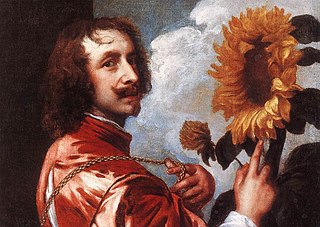
Sir Anthony van Dyck was a Flemish Baroque artist who became the leading court painter in England after success in the Spanish Netherlands and Italy.

Cornelius Johnson or Cornelis Janssens van Ceulen was an English painter of portraits of Dutch or Flemish parentage. He was active in England, from at least 1618 to 1643, when he moved to Middelburg in the Netherlands to escape the English Civil War. Between 1646 and 1652 he lived in Amsterdam, before settling in Utrecht, where he died.
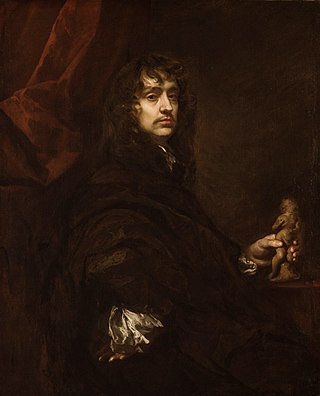
Sir Peter Lely was a painter of Dutch origin whose career was nearly all spent in England, where he became the dominant portrait painter to the court. He became a naturalised British subject and was knighted in 1679.

Marcus Gheeraerts was a Flemish artist working at the Tudor court, described as "the most important artist of quality to work in England in large-scale between Eworth and van Dyck" He was brought to England as a child by his father Marcus Gheeraerts the Elder, also a painter. He became a fashionable portraitist in the last decade of the reign of Elizabeth I under the patronage of her champion and pageant-master Sir Henry Lee. He introduced a new aesthetic in English court painting that captured the essence of a sitter through close observation. He became a favorite portraitist of James I's queen Anne of Denmark, but fell out of fashion in the late 1610s.
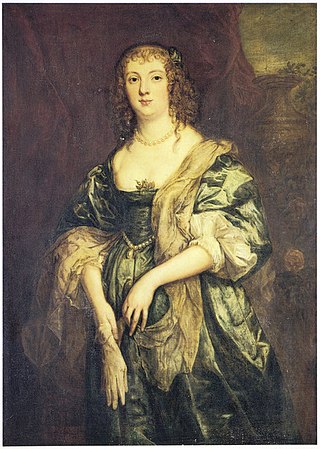
Anne Russell, Countess of Bedford, formerly Lady Anne Carr, was a wealthy English noblewoman, and the wife of William Russell, 5th Earl of Bedford, a peer and soldier during the English Civil War, who after her death was created Duke of Bedford. Her mother was Frances Howard. In about 1638, Anne was the subject of at least two portraits by Flemish painter Anthony van Dyck.

Sir Richard Leveson KB was an English politician who sat in the House of Commons from 1640 to 1642. He supported the Royalist cause during the English Civil War.

Joan Carlile or Carlell or Carliell, was an English portrait painter. She was one of the first British women known to practise painting professionally. Before Carlile, known professional female painters working in Britain were born elsewhere in Europe, principally the Low Countries.
The Lenthall pictures were a number of paintings owned by the Lenthall family and housed at Burford Priory. The collection was publicly commented on by art historians and tourists. It was largely dispersed in two sales in 1808 and 1833, although some works were retained by the family and sold in the late 20th century.

Charles I in Three Positions, also known as the Triple Portrait of Charles I, is an oil painting of Charles I of England painted 1635–1636 by the Flemish artist Sir Anthony van Dyck, showing the king from three viewpoints: left full profile, face on, and right three-quarter profile. It is currently part of the Royal Collection.
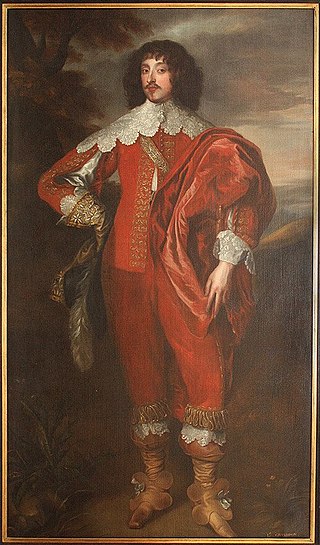
William Villiers, 2nd Viscount Grandison was an Irish peer and Royalist soldier who was fatally wounded during the First English Civil War in 1643.
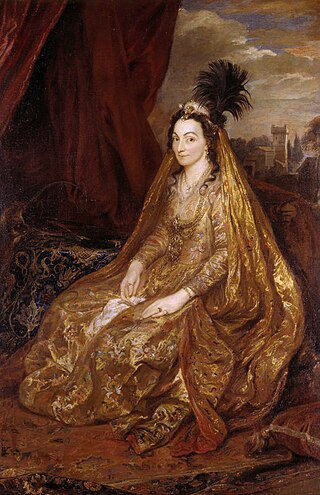
The Portrait of Lady Shirley is a 1622 painting by Sir Anthony van Dyck, a Flemish Baroque artist. It is a portrait of Teresa Sampsonia (1589–1668), a Circassian noblewoman of the Safavid Empire of Iran. She was the wife of Elizabethan English adventurer Robert Shirley, whom she accompanied on his travels and embassies across Europe in the name of the Safavid King (Shah) Abbas the Great. Numerous sketches of the couple appear in Van Dyck's Italian Sketchbooks.
Mary Woodhouse, Lady Killigrew, musician and correspondent of Constantijn Huygens, was the daughter of Henry Woodhouse (MP) of Hickling and Waxham, and Anne Bacon, daughter of Sir Nicholas Bacon. She may have been the "Woodhouse" appointed Maid of Honour to Anne of Denmark in December 1603.

Cecilia Crofts, courtier and maid of honour to Henrietta Maria, subject of poems.

Lord John Stuart and his Brother, Lord Bernard Stuart is a large oil painting by Anthony van Dyck made c.1638. The life-size double portrait depicts the two youngest sons of Esmé Stewart, 3rd Duke of Lennox: Lord John Stewart (1621–1644) and Lord Bernard Stuart (1622–1645), aged about 17 and 16 respectively. The painting measures 237.5 cm × 146.1 cm, and has been held by the National Gallery, London since 1988.

Sir William Killigrew is a 1638 Baroque portrait of Sir William Killigrew (1606–1695) by the Flemish artist Anthony van Dyck. The portrait is twinned with another of his wife, Mary Hill.
Delia Mary, Lady Millar C.V.O., was the wife of the British art historian and Surveyor of the Queen’s Pictures, Sir Oliver Nicholas Millar and an art historian in her own right. A specialist in the art of the Victorian era, she was appointed Commander of the Royal Victorian Order in recognition of her services to the Royal Collection.
George Kirke was a Scottish-born courtier and Member of Parliament for Clitheroe.

Anne Killigrew was a Lady in Waiting to Queen Henrietta Maria, and the first wife of George Kirke who was Groom of the Chamber to Charles I of England.

Margaret Lemon was an English artist's model. She was the most painted female commoner of the seventeenth century, and she was the partner of Anthony van Dyck.

Catherine Murray, Countess of Dysart was a Scottish noblewoman. She was wife of William Murray, 1st Earl of Dysart and mother of Elizabeth, Duchess of Lauderdale. She was responsible for the management of Ham House during the English Civil War, defending it from the encroachment of Parliamentary forces. She was portrayed by prominent artists such as Anthony van Dyck and John Hoskins.
















